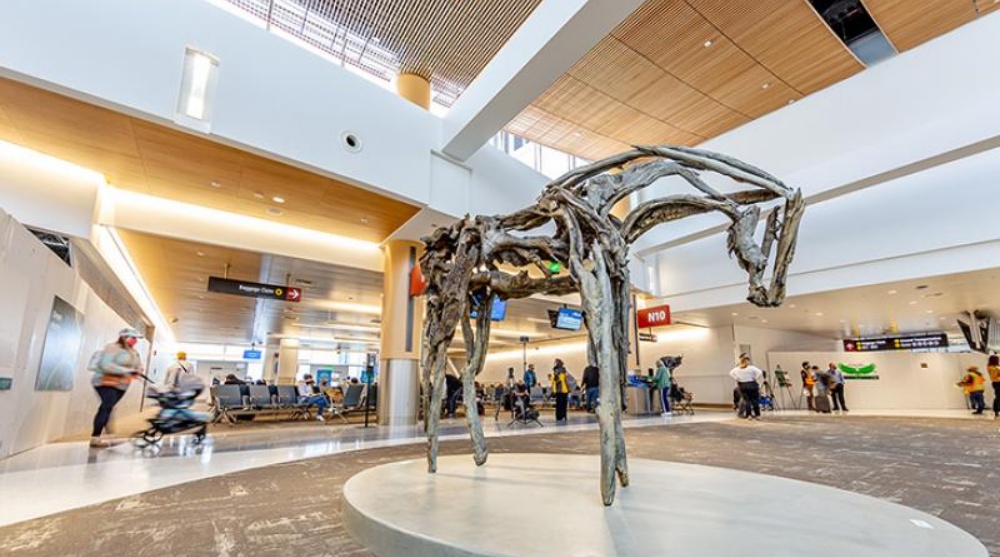

Environmentalists don’t love airports, for obvious reasons. They’re billboards for fuel consumption and potent symbols of private and corporate wealth. But airports are not going away, because they’re essential infrastructure for cities in a connected world.
These contradictions are behind a minor stir among big-name architects who recently withdrew from a climate change activist group that would have barred them from airport design. In the meantime, our own Seattle-Tacoma International Airport continues to expand. Just in time for post-Covid domestic travel, two more gates have opened in the North Satellite, now a base for Alaska Airlines. The Seattle-based airline is making itself at home in the airport, and local architects and artists are helping to make it a home away from home for departing passengers. The company has defied business norms by taking a little more risk with design.
Alaska will take 16 out of a total of 20 gates in the re-built North Satellite. Construction is ongoing, but a media event last week focused on a central, multi-story open area with glass walls, plus works by local artists. The art includes a life-sized horse sculpture by Deborah Butterfield made of bronze pieces cast from driftwood. Also on display is a large wood sculpture by John Grade representing an upside-down tree root system and trunk. Planned installations are in a biophilic vein, including a leafy piece by Krista Birnbaum.
These and more will be housed in the remade shell of the North Satellite, originally built in 1971. The structural bones are still there, but the terminal has been opened up and modernized by popping the ceiling way up so the original structure is now a low-lying frame. Those gathered at the gates will be able to see airplanes rolling around outside, but there’s also lots to look at inside the re-built satellite area. Through the center, a hanging ceiling of wood sticks called The River undulates high overhead.
It’s not surprising that the revised shell of the North Satellite, designed by D.C.-based Fentress Architects with AECOM, supports an innovative sewage system that uses rainwater captured on the roof to flush toilets. Reusing the old structural shell saves energy and keeps the overall footprint of the airport confined. New earthquake protection is provided by a superstructure “hugging” the outside of the satellite.
State-of-the-art air handlers have been added, too, for better protection from Covid and other pathogens. That’s meant to reassure nervous travelers. The overall North Satellite project is ahead of schedule and under budget. That’s a silver lining for the payers, the Port of Seattle and Alaska Airlines, both hard hit by pandemic slowdowns, when all travel has dropped precipitously.

Even before COVID hit in 2019, luxury was built into the North Satellite design. Local design star Graham Baba Architects, with an office on Capitol Hill, has helped redefine luxury by creating an expansive lounge for Alaska passengers in the North Satellite of the terminal. The 15,000-square-foot lounge is pitched to please anyone flying for business or escape. It’s been accumulating design awards in the months since officially opening. Soft and expansive but also no-frills-modern in attitude, it floats above the gateway level in serene, glassy unity with the surrounding atmosphere at one end of the North Satellite. For those who hold tickets and some form of membership, the private lounge is reachable via a central stairway or elevator.
Although it’s open in plan, it was designed to contain four informal zones, according to principal Brett Baba. In addition to the entry, there’s an area called Take A Breath with a free-standing fireplace surrounded by soft, greyish seating. Cut Loose is shorthand for the bar area. Help Yourself is the name of the bistro. Local fabricators created custom elements throughout the space, such as the light fixtures that recall jet engines and recycled cardboard screens at the entry.
Its attitude is very post-COVID Pacific Northwest, with contact optional and distancing seemingly built in. Adding to the culture-forward tone of the place is a door outside the lounge at the mezzanine level that welcomes nursing mothers. The Port of Seattle is spot-on with this one. While no gender-specific language bars entry to any, visitors are admonished to respect the peace and privacy of lounge users. Specially designed booths are furnished with attractive, soft seating and convenient places to set infants, belongings and beverages. There are changing stations. It was practically empty when I saw it, but it serves as a stylish reminder that life goes on.
Discover more from Post Alley
Subscribe to get the latest posts sent to your email.
